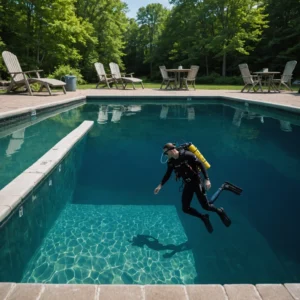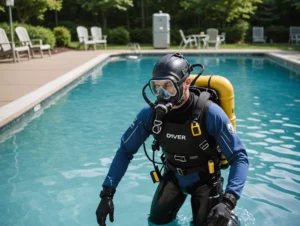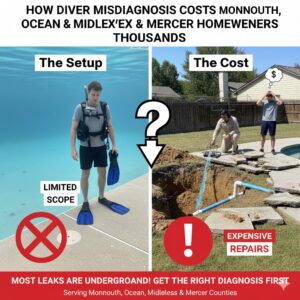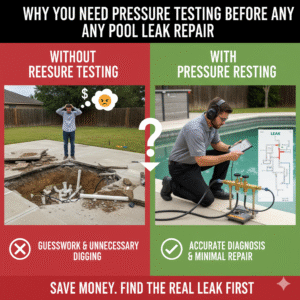Divers Can’t Swim Into Pipes — Why Real Leak Detection Happens Above the Waterline
If a diver can’t fit inside your pool’s plumbing, how can they find a leak there? That’s the question every pool owner should ask before hiring someone with a scuba tank to “look for leaks.” The truth is simple: divers can only see what’s in front of them, and most pool leaks start deep inside pipes, fittings, and connections that no diver can reach.
Leaks Don’t Live Where Divers Can Swim
While divers inspect the inside of the pool, around 40% of all pool leaks occur within plumbing lines that run beneath decks or underground. These pipes carry water between your pump, skimmer, returns, and main drain — and when they crack or separate, they leak below the surface, far away from where a diver can look.
No amount of underwater searching can find a pipe leak hidden several feet underground. Divers can’t enter plumbing lines, can’t pressure test them, and can’t hear the water escaping below the surface. They’re working blind when it comes to your pool’s plumbing system.
Why Diving Alone Doesn’t Work
It’s easy to assume a diver will find a leak because they can “see underwater,” but that’s rarely how detection works. Pool leaks are almost always the result of pressure loss, pipe vibration, or cracked fittings — none of which can be seen from inside the pool. Without testing equipment, a diver has no way to confirm where the leak actually is.
- Divers can’t pressure test plumbing lines — it’s the only way to verify a pipe leak.
- They can’t trace underground sound — water movement must be heard electronically.
- They can’t inspect inside fittings or valves — those require cameras and specialized tools.
The result? Divers patch visible damage that looks like a leak, but the real issue stays hidden underground, wasting water and driving up costs.
Real Leak Detection Stays on the Surface
Professional leak detection specialists use pressure rigs, electronic listening devices, and line tracing tools to find leaks that diving will never reveal. These tests isolate each line, measure pressure loss, and locate the exact point of failure — whether it’s in a skimmer line, return pipe, or underground fitting.
By working above the waterline, they gather accurate data instead of guesses. This means faster, cleaner repairs and no unnecessary digging or resurfacing.
Save Time, Water, and Money
When divers can’t detect leaks in your pipes, the problem doesn’t go away — it grows. Water loss leads to erosion, cracks, and equipment strain. Meanwhile, you’re refilling your pool week after week, paying higher bills and risking structural damage.
Real leak detection happens with instruments, not oxygen tanks. Choose specialists who test pressure, trace sound, and confirm leaks the right way the first time.
Divers Can’t Swim Into Pipes — Trust Professionals Who Can Test What They Can’t See.








